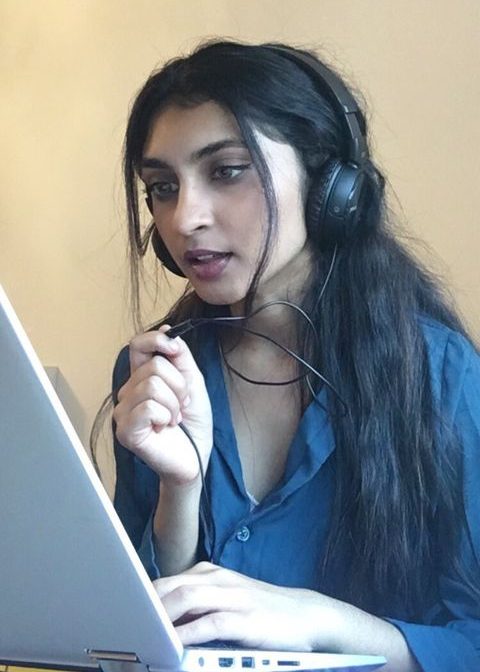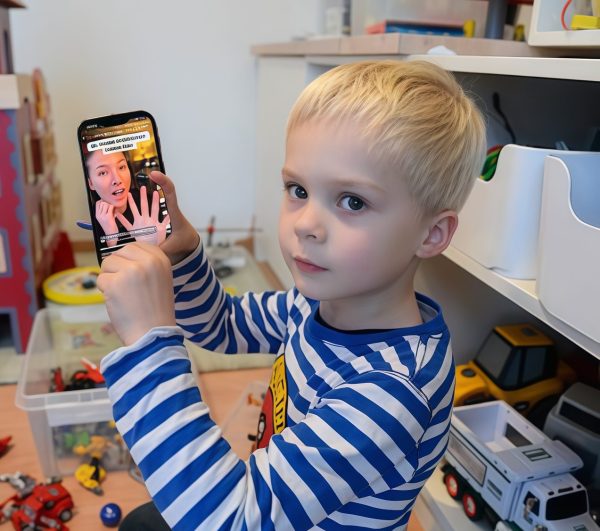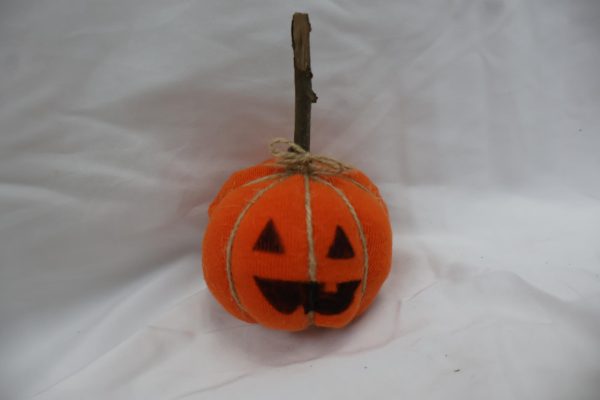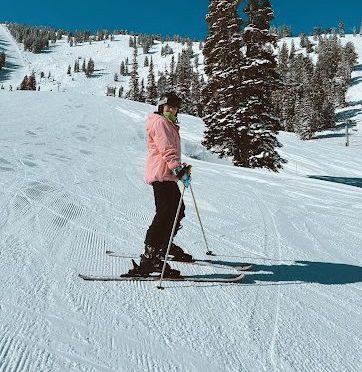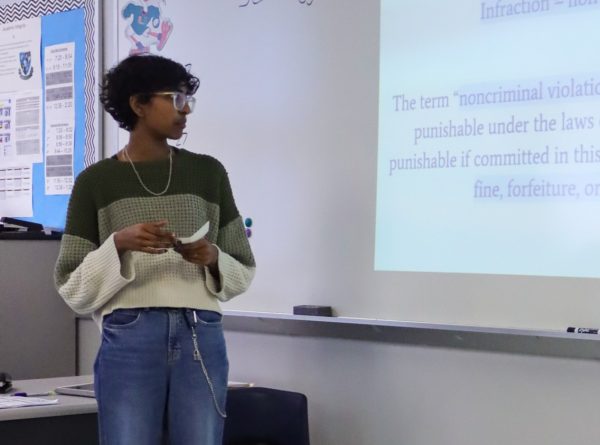On another wavelength
Many enjoy listening to alternative forms of media, such as podcasts, with some people even creating their own.
photo by Pooja Kannan
Junior Pooja Kannan records an episode of her podcast, “Problematic.” Her podcast addresses politics and mental health issues, with episodes released every Saturday.
A fresh listen
Next track. The song you were listening to an hour ago starts playing once again. Next. This time, the song does not change. Spotify’s free system only allows six skips and you have used them all. Once your favorite songs, they are now annoying and cringeworthy. You need something new after scrolling through Spotify’s suggestions, you stumble across…a podcast?
This is how senior Victoria Hayward felt as she packed to move to a new house. Although she had never listened to a podcast before, she came across the crime podcast “Serial Killers” while searching for music and decided to listen to the first episode.
“I had recently become obsessed with ‘Criminal Minds,’ but I can’t watch TV while doing other activities,” Hayward said. “[The podcast episode] took a topic that I find so fascinating, and made it more accessible than a TV show.”
Podcasts consist of a series of audios, basically a voice recording but spicy. Most are available on different streaming platforms such as Spotify, Apple Podcasts and Google Podcasts. Each episode is centered around a different topic, all tied together under the broader umbrella of the show’s theme. With over 800,000 podcasts in existence, there are many different genres and niches ranging from comedy all the way to technology.
“I feel like everyone can find one on a topic they are interested in,” Hayward said.
One of the biggest appeals for podcasts is how easy people find them to listen to; they are easy entertainment for the morning commute or for a simple walk outside. Unlike watching television, they allow for multitasking. Whereas shows and movies require your visual attention and music forces you to sing along or pause in an emotional moment, podcasts are like a side conversation. Junior Rachel Pu first started listening to podcasts as an experiment, but now listens as she draws, using them as background noise to fill her time. She likes to explore different genres and jump around to different shows, but prefers listening to conspiracy podcasts like “Conspiracy Theories.”
“I never sit on my bed and listen to a podcast, I always have to be doing something on the side,” Pu said.
Each podcast provides information or a point of view, and there is one for every type of listener. Freshman Zahra Ateeq likes to listen to the psychology podcast “Hidden Brain” to broaden her perspective on topics such as social media’s toll on a person’s mental health.
“It really helps me process certain ideas around the world and certain feelings, ” Ateeq said. “I even sit down and listen to it before doing homework to motivate myself.”
Podcasts can be an alternative to watching TikTok or YouTube videos. With listeners’ prolonged stay at home, hearing a host talk about their life can alleviate the stir craziness. Most podcast episodes are able to engage the audience to an in-depth look at their topic. Even with a script, the episodes are able to flow naturally like an in-person conversation.
“I think podcasts are engaging. The lack of editing is needed and a lot of the information is not filtered, which allows me to experience whatever conversation is going on,” Pu said.
Sound check
While listening to a podcast is a passive experience, some have gone further, getting directly involved in the conversation by creating their own podcast. Junior Pooja Kannan started her weekly podcast “Problematic” in November, which helps bring awareness to politics and mental health issues. She and her co-host provide their own take on these topics, often incorporating their own personal stories.
“I think it is important for listeners and people in general to hear different points of view from their own,” Kannan said.
Instead of basing a podcast under a specific theme, like the “Problematic” podcast, senior Kevin Cosio centered his own around life experiences, exploring any and every topic he wishes with his friends. He created his first podcast “The Boid Gang Podcast” last year, but has since moved on to “Talk-o Tuesday” in August.
“I wanted to create a memory bank for future reference,” Cosio said. Talking is the most personal and easiest form of doing this.”
Depending on the type of podcast and how in-depth it goes, it can take anywhere from two to 40 hours of work to create one episode. However, podcasting allows hosts to pick up new skills like audio editing and production. Outside of recording, Kannan spends four hours a week with her co-host planning their Instagram feed, looking for guests and doing research.
“Editing and staying consistent is difficult, but doing research on topics has caused me to think way more about my surroundings,” Kannan said.
Although there can be obstacles along the way, in each episode, Cosio and Kannan like gaining insight into other people’s perspectives surrounding their episode topics. Kannan recently had Boston-based rapper Abhisting on for an episode on toxic masculinity and gender norms.
“Since rap culture can be toxic because of its pattern of degrading women to looks and physical appeal, I wanted to have a guest working in that industry,” Kannan said. “It was interesting because we both had very different ways of thinking.”
With production, many might be intimidated when it comes to creating a podcast after seeing the high-budget equipment often required by professionals. In actuality, any microphone and streaming platform will work. While lower in quality, it will get the job done. When it comes down to creating a podcast, apps like Anchor and Podbean provide a platform to do so. They boast an in-app recording feature as well as automatic distribution to different streaming platforms. Many podcasters have turned to Zoom to record episodes as well, as guests and co-hosts can easily record even when far away from each other. Cosio believes that if someone has a podcast idea, they should go for it.
“All you need is your phone starting out, and an idea. Just keep up at it and eventually, things will work out and get better,” Cosio said.
There is a huge audience base for podcasts. Even with relatively new podcasts, both Cosio and Kannan have had good engagement with their audience. Their audience feedback pushes them to improve and continue producing. Senior Nicolas Cai listens to “Talk-o Tuesday” occasionally, enjoying that he can relate to the hosts’ experiences.
“It provides a nice change of pace from my regular coursework. The wide assortment of topics makes it interesting because I can get invested in the next discussion,” Cai said. “I live vicariously through those conversations.”
Most people under 18 don’t really think about listening to podcasts, feeling that they are “boring” or “monotone.” However, avid podcast listeners like Pu feel that people should give them a chance.
“[Podcasts] are severely underrated and do not get all the love they should be getting. It’s nice to have a change from just listening to music,” Pu said.
Your donation will support the student journalists of Hagerty High School. We are an ad-free publication, and your contribution helps us publish six issues of the BluePrint and cover our annual website hosting costs. Thank you so much!


